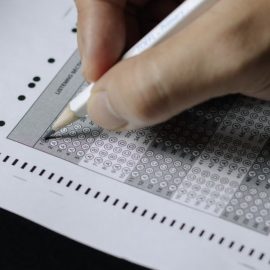

This article is an excerpt from the Shortform summary of "Moonwalking With Einstein" by Joshua Foer. Shortform has the world's best summaries of books you should be reading.
Like this article? Sign up for a free trial here .
Did you know that you can actually improve your memory by using memory enhancing techniques? What are the best memory techniques, and how do these techniques work?
Memory enhancing techniques are strategies used by mnemonists to help improve recall. But you can also learn the memory-enhancing techniques. Doing so can help you feel better about your life and improve your efficiency.
Read about the different types of memory enhancing techniques and how they work.
Memory Enhancing Techniques
The goal of memory enhancing techniques is to transform information into a format the brain is naturally good at understanding—meaningful images and places. To do this, you’ll use the method of loci, which is the foundation for the memory techniques that follow.
The best memory techniques help you remember information whil also strengthening your memory overall. The method of loci involves placing images of whatever you need to remember inside a “memory palace,” which is a memory of a real place you know very well, such as your childhood home. For example, if your shopping list contains blueberries, crackers, cereal, and beer and you wanted to memorize this shopping list, you might mentally place the blueberries in the mailbox at the end of your driveway, the crackers on the front lawn, the cereal in front of the front door, and the beer on the entranceway mat. When you need to remember the list, you simply mentally tour your memory palace and look for the objects you left in significant locations.
Some things you need to remember might not lend themselves well to imagery. There are some more structured memory enhancing techniques for remembering cards, numbers, and words below, but in general, you can transform abstract things to remember into images using creativity. You’ll remember images best if you can harness the brain’s natural strengths and interests to find the best memory techniques. Try to make images:
- Novel. If you’ve seen something before, you’re less likely to remember a specific instance of it.
- For example, if you need to remember to charge your phone, imagine your phone and charger having a silly conversation.
- Lewd or funny. The brain is naturally interested in both of these things.
- For example, if you need to remember to go to the bank, imagine a bunch of nude bank robbers.
- Multisensory. The more cues you can create for a memory, the easier it will be to recall it.
- For example, if you need to remember to pick up horseradish, imagine the smell, taste, and texture of it as well as the visual image.
- Personal. You’ll remember things better if they relate to what’s already in your head because they have a web to fit into.
- For example, if you’re interested in military history, use tanks and planes in your images.
In addition to the method of loci, there are five additional memory memory retention techniques. You can combine any of them with the method of loci—once you’ve used the technique to transform information into an image or more memorable form, you can store it in your memory palace.
1. Punning
Punning is one of the best and most fun memorization techniques. To use punning, change an abstract word into a concrete word by using rhymes or puns. You can also employ alliteration or repetition. For example, if you need to remember the title of the book The Joy of Cooking, you might picture a boy who’s good-looking.
Punning can also be used to memorize word-for-word. For example, mental athletes assign images to words like “and” and “the” and then picture a string of images to remember the exact words. One German mnemonist remembers the word “and” by picturing a circle because the German word for round, “rund,” rhymes with “and.”
2. Baker/baker Paradox
This is one of the memory retention techniques that also helps us understand how memory works. The Baker/baker paradox is a phenomenon you can manipulate to help yourself remember names. If you’re shown a picture of a person and told her last name is Baker, you won’t remember “baker” as well as if you’re told she is a baker. This is because “Baker,” as a name, is an abstract concept without much to associate with it. As a profession, however, “baker” is associated with things like flour, the smell of cookies, the heat of an oven, and so on.
To remember people’s names, create an image that combines what they look like with a visual of something that will cue a memory of their name. For example, the name Joshua Foer could be remembered by imaging Joshua (he looks like this) joshing you so hard you break into four pieces.
3. “Method Acting”
This is one of the most interesting memory retention techniques since it resembles method acting. of memorizing word-for-word that’s similar to method acting. To use this method, break sections of a text into small chunks and assign them emotions rather than images.
4. Chunking
Your working memory can only hold five to nine pieces of information at once, so if you need to remember something like a 16-digit credit card number, it’s a tall order. Chunking is one of the best memorization techniques since it is a method of breaking and combining individual things into meaningful groups so that you have fewer things to remember.
For example, if you had to remember the letters ONCEUPONATIME, that’s 13 individual letters, more than your working memory can handle. However, if you group those letters into four words, ONCE UPON A TIME, then you only have to remember four things instead of 13.
5. The Major System
The major system is a method of converting numbers into sounds, then into words, then into images. You can use it to memorize any string of numbers, such as your SSN or phone numbers. Here’s how it works:
- Memorize the digit-to-letter conversions:
- 0=S
- 1=T/D
- 2=N
- 3=M
- 4=R
- 5=L
- 6=Sh/Ch
- 7=K/G
- 8=F/V
- 9=P/B
- Convert your number into letters. For example, the number 43 would be RM.
- Add vowels to the letters to make a word. For example, RM could become “rim.”
- Create an image associated with the word. For example, you could picture the edge of a cup for “rim.”
- Place the image in your memory palace.
6. The Person-Action-Object (PAO) System
Another one of the best memorization techniques is PAO. The person-action-object system is a method for remembering the order of numbers or cards. This method is used primarily by mental athletes who have to memorize hundreds of digits—if you’re just memorizing everyday numbers such as phone numbers, the major system will likely serve your purposes.
Here’s how the PAO works for numbers:
- Come up with 100 sentences that involve a different person acting on a different object.
- Assign each sentence to each two-digit number between 00 and 99.
- Example #1: 45 is Albert Einstein brushing his hair
- Example #2: 78 is Michael Jackson moonwalking a stage.
- Example #3: 89 is Mr. Dressup opening the tickle trunk.
- When presented with a number to memorize, break it into six-digit chunks.
- For example, 457889894578 becomes 457889 and 894578.
- Combine the person from the first two digits with the action from the second two digits with the object from the last digits and create a new image.
- Example #1: 457889 is Einstein moonwalking on the tickle trunk.
- Example #2: 894578 is Mr. Dressup brushing a stage.
- Place the images in your memory palace.
Here’s how it works for cards:
- Create 52 person-action-object sentences.
- Attach one to each card.
- When presented with a deck of cards to memorize, break it into groups of three cards.
- Combine the person of the first card with the action of the second card and the object of the third. Do the same for each group of three cards.
- Place the resulting images in your memory palace.
Competitive mnemonists are always refining this method and some have even gone beyond creating images for two-digit numbers or single cards, instead coming up with images for every three-digit number or two-card combination.
Memory enhancing techniques can help anyone improve their memory. Not only do the best memorization techniques help you retain information, but practicing them can make them a force of habit and strengthen your memory overall.

———End of Preview———
Like what you just read? Read the rest of the world's best summary of Joshua Foer's "Moonwalking With Einstein" at Shortform .
Here's what you'll find in our full Moonwalking With Einstein summary :
- The memory techniques that took the author from novice to US memory champion in one year
- The 6 key types of memory we use everyday
- Why memory isn't just genetic, and how you can improve your memory with the right techniques






